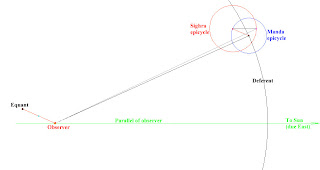
In Hindu Trignometry ( which is derived from Trikonamithi, trikona = triangle and trignon = triangle ), Jya resembles the modern Sine and Koti Jya, the cosine.
But in actuality, Jya is R Sin, that is Radius multiplied by modern sine.
By Jya, Brahmagupta meant 5 degrees of a circle. In Hindu Sine Tables and Tan Tables, the values are given for 5 degrees, 10 degrees, 15 degrees etc so that the Astro Maths students need not bother about using the Indian trignometric and inverse functions. Aryabhata’s sine tables are found to be accurate, when compared to modern sine tables.
In other words, one Zodiacal Constellation, which is 30 degrees is made up of 6 jyas and a total of 72 Jyas constitute the Zodiac.
Koti Jya is R Cos, that is Radius multiplied by modern cosine.
Utkram Jya is the reverse sine, defined as 1- cos x. Since the Reverse sine resembled an arrow, Brahmagupta called it Sara. And since the Arcsine resembled a bow, he called it Chapa.
Bhujajya is radius multiplied by modern sine and bhujachapa is the arcsine. Kotijya is radius multiplied by modern cosine and Kotichapa is arccos. Sparshjya is tan and sparshachapa is arctan.
Aryabhata’s Sine Table was the first ever constructed sine table in the History of Maths.
This is Aryabhata’s Sine Table given for different Kakshyas ( One Kakshya is 3 degrees 45 mins, one eighth of 30 degrees Zodiacal Sign )
Sl. No Angle ( A ) (in degrees, arcminutes) Value in Āryabhaṭa’s numerical notation
(in Devanagari) Value in Āryabhaṭa’s numerical notation (in ISO 15919 transliteration) Value in Arabic numerals Āryabhaṭa’s value of jya (A) Modern value of jya (A)
(3438 × sin (A))
1 03° 45′ मखि makhi 225 225′ 224.8560
2 07° 30′ भखि bhakhi 224 449′ 448.7490
3 11° 15′ फखि phakhi 222 671′ 670.7205
4 15° 00′ धखि dhakhi 219 890′ 889.8199
5 18° 45′ णखि ṇakhi 215 1105′ 1105.1089
6 22° 30′ ञखि ñakhi 210 1315′ 1315.6656
7 26° 15′ ङखि ṅakhi 205 1520′ 1520.5885
8 30° 00′ हस्झ hasjha 199 1719′ 1719.0000
9 33° 45′ स्ककि skaki 191 1910′ 1910.0505
10 37° 30′ किष्ग kiṣga 183 2093′ 2092.9218
11 41° 15′ श्घकि śghaki 174 2267′ 2266.8309
12 45° 00′ किघ्व kighva 164 2431′ 2431.0331
13 48° 45′ घ्लकि ghlaki 154 2585′ 2584.8253
14 52° 30′ किग्र kigra 143 2728′ 2727.5488
15 56° 15′ हक्य hakya 131 2859′ 2858.5925
16 60° 00′ धकि dhaki 119 2978′ 2977.3953
17 63° 45′ किच kica 106 3084′ 3083.4485
18 67° 30′ स्ग sga 93 3177′ 3176.2978
19 71° 15′ झश jhaśa 79 3256′ 3255.5458
20 75° 00′ ङ्व ṅva 65 3321′ 3320.8530
21 78° 45′ क्ल kla 51 3372′ 3371.9398
22 82° 30′ प्त pta 37 3409′ 3408.5874
23 86° 15′ फ pha 22 3431′ 3430.6390
24 90° 00′ छ cha 7 3438′ 3438.0000
Sine Table by courtesy www.wikipedia.org





